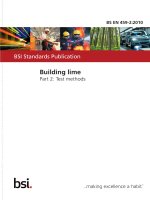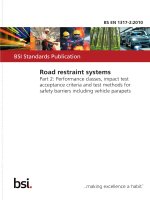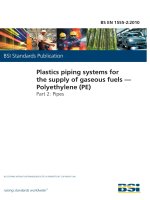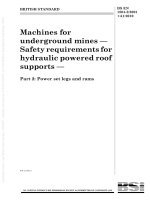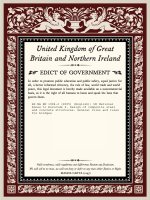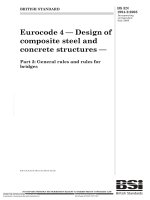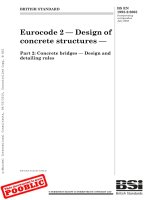Bsi bs en 61300 2 24 2010
Bạn đang xem bản rút gọn của tài liệu. Xem và tải ngay bản đầy đủ của tài liệu tại đây (1.31 MB, 18 trang )
Licensed copy: Bradford University, University of Bradford, Version correct as of 21/03/2012 14:26, (c) The British Standards Institution 2012
BS EN 61300-2-24:2010
BSI Standards Publication
Fibre optic interconnecting
devices and passive
components – Basic test and
measurement procedures
Part 2-24: Tests — Screen testing of ceramic
alignment split sleeve by stress application
NO COPYING WITHOUT BSI PERMISSION EXCEPT AS PERMITTED BY COPYRIGHT LAW
raising standards worldwide™
BRITISH STANDARD
BS EN 61300-2-24:2010
Licensed copy: Bradford University, University of Bradford, Version correct as of 21/03/2012 14:26, (c) The British Standards Institution 2012
National foreword
This British Standard is the UK implementation of EN 61300-2-24:2010. It is
identical to IEC 61300-2-24:2010. It supersedes BS EN 61300-2-24:2000
which is withdrawn.
The UK participation in its preparation was entrusted by Technical Committee
GEL/86, Fibre optics, to Subcommittee GEL/86/2, Fibre optic interconnecting
devices and passive components.
A list of organizations represented on this committee can be obtained on
request to its secretary.
This publication does not purport to include all the necessary provisions of a
contract. Users are responsible for its correct application.
© BSI 2010
ISBN 978 0 580 63662 2
ICS 33.180.20
Compliance with a British Standard cannot confer immunity from
legal obligations.
This British Standard was published under the authority of the Standards
Policy and Strategy Committee on 31 August 2010.
Amendments issued since publication
Amd. No.
Date
Text affected
BS EN 61300-2-24:2010
EUROPEAN STANDARD
EN 61300-2-24
Licensed copy: Bradford University, University of Bradford, Version correct as of 21/03/2012 14:26, (c) The British Standards Institution 2012
NORME EUROPÉENNE
July 2010
EUROPÄISCHE NORM
ICS 33.180.20
Supersedes EN 61300-2-24:2000
English version
Fibre optic interconnecting devices and passive components Basic test and measurement procedures Part 2-24: Tests Screen testing of ceramic alignment split sleeve by stress application
(IEC 61300-2-24:2010)
Dispositifs d'interconnexion et composants
passifs à fibres optiques Méthodes fondamentales d'essais
et de mesures Partie 2-24: Essais Essai de sélection du manchon fendu
d'alignement en céramique
par l'application de contrainte
(CEI 61300-2-24:2010)
Lichtwellenleiter Verbindungselemente und passive
Bauteile Grundlegende Prüf- und Messverfahren Teil 2-24: Prüfungen Sortierprüfung keramischer Zentrierhülsen
mit Beanspruchung
(IEC 61300-2-24:2010)
This European Standard was approved by CENELEC on 2010-07-01. CENELEC members are bound to comply
with the CEN/CENELEC Internal Regulations which stipulate the conditions for giving this European Standard
the status of a national standard without any alteration.
Up-to-date lists and bibliographical references concerning such national standards may be obtained on
application to the Central Secretariat or to any CENELEC member.
This European Standard exists in three official versions (English, French, German). A version in any other
language made by translation under the responsibility of a CENELEC member into its own language and notified
to the Central Secretariat has the same status as the official versions.
CENELEC members are the national electrotechnical committees of Austria, Belgium, Bulgaria, Croatia, Cyprus,
the Czech Republic, Denmark, Estonia, Finland, France, Germany, Greece, Hungary, Iceland, Ireland, Italy,
Latvia, Lithuania, Luxembourg, Malta, the Netherlands, Norway, Poland, Portugal, Romania, Slovakia, Slovenia,
Spain, Sweden, Switzerland and the United Kingdom.
CENELEC
European Committee for Electrotechnical Standardization
Comité Européen de Normalisation Electrotechnique
Europäisches Komitee für Elektrotechnische Normung
Management Centre: Avenue Marnix 17, B - 1000 Brussels
© 2010 CENELEC -
All rights of exploitation in any form and by any means reserved worldwide for CENELEC members.
Ref. No. EN 61300-2-24:2010 E
BS EN 61300-2-24:2010
EN 61300-2-24:2010
-2-
Licensed copy: Bradford University, University of Bradford, Version correct as of 21/03/2012 14:26, (c) The British Standards Institution 2012
Foreword
The text of document 86B/2967/FDIS, future edition 2 of IEC 61300-2-24, prepared by SC 86B, Fibre
optic interconnecting devices and passive components, of IEC TC 86, Fibre optics, was submitted to the
IEC-CENELEC parallel vote and was approved by CENELEC as EN 61300-2-24 on 2010-07-01.
This European Standard supersedes EN 61300-2-24:2000.
EN 61300-2-24:2010 constitutes a technical revision. Specific technical changes involve the addition of a
dimension example of the reference gauge and the plate for the ceramic sleeve and a commonly used
ceramic alignment sleeve for the 1,25 mm ceramic sleeve.
Attention is drawn to the possibility that some of the elements of this document may be the subject of
patent rights. CEN and CENELEC shall not be held responsible for identifying any or all such patent
rights.
The following dates were fixed:
– latest date by which the EN has to be implemented
at national level by publication of an identical
national standard or by endorsement
(dop)
2011-04-01
– latest date by which the national standards conflicting
with the EN have to be withdrawn
(dow)
2011-07-01
__________
Endorsement notice
The text of the International Standard IEC 61300-2-24:2010 was approved by CENELEC as a European
Standard without any modification.
__________
BS EN 61300-2-24:2010
–2–
61300-2-24 © IEC:2010(E)
Licensed copy: Bradford University, University of Bradford, Version correct as of 21/03/2012 14:26, (c) The British Standards Institution 2012
CONTENTS
1
Scope ...............................................................................................................................5
2
General description ..........................................................................................................5
3
Apparatus .........................................................................................................................5
4
Procedure ........................................................................................................................7
5
Details to be specified ......................................................................................................7
Annex A (informative) Static fatigue for zirconia alignment sleeve.......................................... 8
Bibliography.......................................................................................................................... 15
Figure 1 – Apparatus used for screen testing of a ceramic alignment sleeve ...........................6
Figure A.1 – Model of time-varying proof stress for a zirconia sleeve .................................... 10
Figure A.2 – Calculated contour lines of gauge retention force and working stress
along with inner and outer diameter of a zirconia sleeve ....................................................... 11
Figure A.3 – Calculated general relationship between σ p / σ a and t e , satisfying 0,1 FIT
for 20 years use .................................................................................................................... 12
Figure A.4 – Calculated failure probability of screened zirconia sleeves along with
working time ......................................................................................................................... 12
Figure A.5 – Measured and calculated strength distribution of 2,5 mm zirconia sleeves
(comparison between sleeves, extended proof tested or not) ................................................ 13
Figure A.6 – Measured strength distribution of 1,25 mm zirconia sleeves (comparison
between sleeves, extended proof tested or not) .................................................................... 14
Table 1 – Dimension example of the reference gauge and the plate for the ceramic
sleeve .....................................................................................................................................6
Table 2 – Dimension example of a commonly used ceramic alignment sleeve......................... 7
Table A.1 – Measured static fatigue parameters for zirconia sleeves .................................... 11
BS EN 61300-2-24:2010
Licensed copy: Bradford University, University of Bradford, Version correct as of 21/03/2012 14:26, (c) The British Standards Institution 2012
61300-2-24 © IEC:2010(E)
–5–
FIBRE OPTIC INTERCONNECTING
DEVICES AND PASSIVE COMPONENTS –
BASIC TEST AND MEASUREMENT PROCEDURES –
Part 2-24: Tests –
Screen testing of ceramic alignment
split sleeve by stress application
1
Scope
The purpose of this part of IEC 61300 is to identify weaknesses in a ceramic alignment split
sleeve which could lead to early failure of the component.
2
General description
Ceramic alignment sleeves are important components often used in the adaptor of plugadaptor-plug optical connector sets. By using the method described, the component is
subjected to a proof stress greater than would be experienced under normal service
conditions. This enables weak products to be screened out.
3
Apparatus
The apparatus and arrangement necessary to perform this screening procedure are shown in
Figure 1. The material needed consists of the following:
a) a reference gauge made of ceramic with a sleeve-holding section, a tapered section and a
stress-applying section. The diameter of each section is dependent on the dimensions of
the product being screened. The length of the sleeve-holding section and the stressapplying section should be greater than the component being tested;
b) plates A and B, each having a clearance hole in the centre to allow the plate to move a
sample of a ceramic alignment split sleeve on the reference gauge.
BS EN 61300-2-24:2010
61300-2-24 © IEC:2010(E)
Licensed copy: Bradford University, University of Bradford, Version correct as of 21/03/2012 14:26, (c) The British Standards Institution 2012
–6–
∅E
∅D
Tapered section
Sleeve holding section
A
Stress applying section
C
B
Fixed section
IEC 1487/99
Figure 1a – Reference gauge
H
∅F
∅G
IEC 1488/99
Figure 1b – Plate A and plate B
Figure 1 – Apparatus used for screen testing of a ceramic alignment sleeve
Table 1 shows the dimension of the reference gauge and the plate for the ceramic split sleeve.
A dimension of the stress-applying section diameter (E) is shown for a commonly used
ceramic alignment sleeve in Table 2.
Table 1 – Dimension example of the reference gauge and the plate for
the ceramic sleeve
Notes
For 1,25 mm gauge
For 2,5 mm gauge
Dimension
mm
Dimension
mm
A
9
14
B
5
5
C
9
14
NOTE 2
D
–
–
NOTE 1
E
1,259 0 ± 0,000 5
F
–
–
G
20
20
H
2
2
Reference
NOTE 2
2,515
NOTE 1
This diameter should be less than the inner diameter of the split sleeve.
NOTE 2
Surface finish in this area Ra = 0,2 μm.
NOTE 3
Dimension F should be greater than dimension E, and less than sleeve ØD.
NOTE 3
BS EN 61300-2-24:2010
61300-2-24 © IEC:2010(E)
–7–
Licensed copy: Bradford University, University of Bradford, Version correct as of 21/03/2012 14:26, (c) The British Standards Institution 2012
Table 2 – Dimension example of a commonly used ceramic
alignment sleeve
Items
4
For 1,25 mm
For 2,5 mm
Dimension
mm
Dimension
mm
Length
6,8
10,1
Outer diameter
1,62
3,2
Inner diameter (ref.)
1,246
2,49
Split section width
6,8
10,1
Procedure
This test should be carried out under a 23 °C ± 2 °C environmental temperature condition.
The procedure is as follows.
a) Insert plate A into the reference gauge and set it at the fixed end of the reference gauge.
b) Moisten the inside surface of a ceramic split sleeve sample with distilled water (for
example using a cotton bud). Only touch the sleeve with suitable tools.
c) The sample sleeve is inserted onto the sleeve-holding part and set just in front of the
tapered part of the reference gauge.
d) Insert plate B into the left-hand side of the sample sleeve and move the sample sleeve
onto the stress-applying part until the sample sleeve touches plate A (within approximately
1 s).
e) The sample sleeve should be held for 3 s under the stressed state.
f)
After 3 s, stress applied to the sample sleeve is removed by moving plate A to the lefthand side (within approximately 1 s).
g) In the course of the procedure from d) to f), samples without damage (breakage or crack)
should be selected as acceptable sleeves.
5
Details to be specified
The following details shall be specified depending on the sample sleeve size in the detail
specification:
−
diameter of sleeve-holding part of reference gauge (ØD);
−
diameter of stress-applying part of reference gauge (ØE);
−
length of sleeve-holding part (A) and stress-applying part (C);
−
diameter of the center hole of plates A and B (ØF);
−
deviations from test procedure.
BS EN 61300-2-24:2010
Licensed copy: Bradford University, University of Bradford, Version correct as of 21/03/2012 14:26, (c) The British Standards Institution 2012
–8–
61300-2-24 © IEC:2010(E)
Annex A
(informative)
Static fatigue for zirconia alignment sleeve
A.1
Prediction of failure probability by static fatigue
This annex applies primarily to 2,5 mm zirconia alignment sleeves supported by references [1]
to [5] 1) . For 1,25 mm zirconia sleeves, a comprehensive analysis is referenced [6] and the
strength distribution is shown in Figure A.6. Micro-cracks essentially exist on the surface or
inside of ceramics. Therefore, fracture due to static fatigue occurs in ceramics under lower
stress than the characteristic strength of the materials because of crack propagation in
ceramic materials [1] [2].
Assurance of reliable optical fibre connections requires the prediction of failure probability of
the zirconia sleeves under working stress needed to align the ferrules.
Assuming aligned ferrules of optical connectors, the zirconia sleeves are allowed to stand
under a constant stress, as working stress σ a . Based on the theories of Weibull statistics and
slow crack growth for brittle materials, cumulative failure probability F of the zirconia sleeves
suffering from working stress is given by the following equation:
ln
m
1
=
ln σ aN t a + ln γ
1− F
N −1
(A.1)
with
γ ≡
β≡
Ve
σ 0m
β m / (N −2)
2
( N − 2)
(N − 2) AY 2 K IC
where
ta
is the working time during which the working stress σ a is applied;
m, V e and σ 0 are the Weibull modulus, effective volume, and normalization constant to
express the failure probability by the Weibull statistics theory, respectively;
Y
is the geometry constant;
K IC
is the critical stress intensity factor;
A and N
are crack propagation constants of the brittle materials [2].
—————————
1) Figures in square brackets refer to the Bibliography.
BS EN 61300-2-24:2010
Licensed copy: Bradford University, University of Bradford, Version correct as of 21/03/2012 14:26, (c) The British Standards Institution 2012
61300-2-24 © IEC:2010(E)
–9–
These crack propagation constants depend on environmental conditions such as temperature,
humidity, atmosphere, and material characteristics. Therefore, if m, N and γ values are
estimated, the static fatigue life time of sleeves is predicted. The N value is estimated by the
dynamic fatigue test that measures the strength of a sleeve corresponding variable of the
proportional increased stress coefficient σ ' in MPa/s. On the other hand, the relationship
between F, strength σ f of sleeves and σ ' is given by executing the sleeve destructive test.
The slope m and the intercept ln σ are estimated from equation (A.2).
(N + 1) /(N −1)
σf
1
= m ln
+ ln γ
1− F
{(N + 1)σ ′}1 /(N − 2)
ln
A.2
(A.2)
Reliability improvement by proof test
In order to improve the reliability of the zirconia sleeve against fracture due to static fatigue, a
proof test that initially eliminates weak zirconia sleeves by applying a greater stress (called
proof stress) than the working stress is effective. Fatigue also occurs under the proof stress.
However, the proof test conditions should be decided in order to take into consideration
fatigue during the proof test [3] [4].
When the proof test is performed, the proof stress σ p applied to the zirconia changes
trapezoidally along with time as shown in Figure A.1. In this figure, stress change is defined
as follows:
0 < t ≤ tl :
σ (t) = σ 't
tl < t ≤ tl + tp :
σ (t) = σ p
σ (t) = σ p - σ 't
t l +t p < t ≤ t l +t p +t u :
where
σ´ = σp / tl = σp / tu
The cumulative failure probability F r after proof testing is given by equation (A.3):
⎡⎧
1
= ln ⎢⎨ σ aN ta
ln
⎢⎩
1 − Fr
⎣
( )
with
ζ ≡ ⎛⎜σ p p t e ⎞⎟
N
⎝
1 /(Np − 2 )
⎠
⎛ 1 /(N − 2) ⎞
⎜ β
⎟
≡⎜
δ ≡
1 /(N p − 2) ⎟
γ
⎜ βp
⎟
⎝
⎠
γp
m
( N p − 2)/( N − 2 )
+ζ
( N p − 2) ( N p − 2 ) / m ⎫
δ
⎬
⎭
m /( N p − 2)
⎤
− ζ m δ ⎥ + ln γ
⎥
⎦
(A.3)
BS EN 61300-2-24:2010
61300-2-24 © IEC:2010(E)
– 10 –
Licensed copy: Bradford University, University of Bradford, Version correct as of 21/03/2012 14:26, (c) The British Standards Institution 2012
γp ≡
Ve
m
/(N − 2)
σ 0m β p p
t + tl
te ≡ t p + u
Np + 1
where N p and β p are N and β value under the proof test environment, respectively.
Proof
stress
tl
tp
tu
σp
0
Test time
IEC 1489/99
Figure A.1 – Model of time-varying proof stress for a zirconia sleeve
A.3
A.3.1
Method of proof test
Stress design for zirconia alignment sleeve
Figure A.2 shows calculated contour lines of the gauge retention force f r and working stress
σ a along with inner and outer diameters of a zirconia sleeve. Modelling the zirconia sleeve as
a curved beam, the gripping force and the working stress are calculated analytically. In
calculation, length, maximum static frictional coefficient and Young's modulus of the zirconia
sleeve are 11,4 mm, 0,1 and 196 GPa, respectively. Considering operational difficulty and a
low yield rate in proof testing, proof stress shall be kept as small as possible. For example, as
the maximum gauge retention force and the maximum working stress satisfies the abovementioned condition and the safety coefficient of around 10 against zirconia characteristic
strength of 1 200 MPa respectively, the outer diameter of zirconia sleeve is designed with a
value of 3,2 mm. From Figure A.2, the maximum working stress with a 3,2 mm outer diameter
becomes 130 MPa (gauge retention force is 3,9 N, inner diameter is 2,490 mm).
BS EN 61300-2-24:2010
61300-2-24 © IEC:2010(E)
– 11 –
2,500
Inner diameter of sleeve
Licensed copy: Bradford University, University of Bradford, Version correct as of 21/03/2012 14:26, (c) The British Standards Institution 2012
Dimensions in millimetres
65 MPa
2,495
2,0 N
2,490
130 MPa
2,485
Gauge retention force
3,9 N
2,480
3,0
3,1
Working stress
3,2
3,3
3,4
Outer diameter of sleeve
IEC 1490/99
Figure A.2 – Calculated contour lines of gauge retention force and working stress along
with inner and outer diameter of a zirconia sleeve
A.3.2
Conditions for proof test
Ordinarily, components for switchboard and transmission equipment require very low failure
probability (for example under 0,1 FIT during 20 years). In order to decide proof test
conditions that make a zirconia sleeve satisfy required failure probability, parameters m , N ,
N p , γ and γ p in equation (A.3) shall be estimated. Table A.1 shows these estimated
parameters using 3 mol % Y 2 O 3 -ZrO 2 sleeves. According to equation (A.3), by using
parameters in Table A.1, a general relationship between σ p / σ a and t e , satisfying 0,1 FIT
during 20 years use, is shown in Figure A.3.
Table A.1 – Measured static fatigue parameters for zirconia sleeves
Parameters
25 °C in water
85 °C in water
m
5,5 to 7,1
5,5 to 6,3
N or N p
28 to 40
22 to 35
In γ or In γ p
–43,3 to –53,9
–40,7 to –47,8
BS EN 61300-2-24:2010
61300-2-24 © IEC:2010(E)
– 12 –
Stress ratio
σp/σa
3,5
3,0
2,5
2,0
Te
Test time te (arbitrary unit)
IEC 1491/99
Figure A.3 – Calculated general relationship between σ p / σ a and t e , satisfying 0,1 FIT
for 20 years use
Working and proof test environments are assumed as 85 °C in water and 25 °C in water
respectively. From Figure A.3, “T e ” is the time for σ p / σ a ≈ 2,7, which is almost saturated against t e .
Failure probability of zirconia sleeves, which are screened on the condition σ p / σ a ≈ 2,7, t e =
T e , and 0,1 FIT reference along with working time t a are shown in Figure A.4. It is clear that
the proof test ensures the failure probability under 0,1 FIT during 20 years of use.
0
20 years
−1
−2
Failure probability, log F
Licensed copy: Bradford University, University of Bradford, Version correct as of 21/03/2012 14:26, (c) The British Standards Institution 2012
4,0
−3
−4
0,1 FIT
−5
−6
−7
−8
σp/ σa ≈ 3
te = Te
−9
−10
0,1
1
10
Working time ta in years
100
IEC 1492/99
Figure A.4 – Calculated failure probability of screened zirconia sleeves along
with working time
BS EN 61300-2-24:2010
61300-2-24 © IEC:2010(E)
Experimental verification of proof test
Applying the above-mentioned theory for the proof test to real zirconia sleeves, improvement
of reliability is experimentally verified. The assumed working time is around 20 years,
therefore the verification in a practical environment entails considerable difficulties.
Consequently, by performing two kinds of comparison between theory and experiment, validity
of the proof test is confirmed.
A.3.4
Strength distribution after proof test
Effective elimination of weak sleeves by proof test is experimentally verified. Destroying
screened sleeves that just passed the proof test, by a proportional increased stress σ ' , with a
cumulative failure probability F r of the screened sleeves is given by equation (A.4):
m /( np − 2)
⎤
⎡⎧
Np +1
⎫
⎥
⎢⎪ σ f
1
Np − 2 ⎪
ln
− ζ m ⎥ + ln γ p
+ζ
= ln ⎢⎨
⎬
′
1 − Fr
⎪
⎥
⎢⎪⎩ σ (N p + 1)
⎭
⎦
⎣
(A.4)
Figure A.5 shows measured strength distribution of 2,5 mm zirconia sleeves and calculated
results using equation (A.4). To emphasize the efficiency of the proof test, a 1 000 MPa proof
stress σ p and 10 s of testing time t p , t u and t l were adopted as the proof test conditions. The
calculation was carried out using the values of m = 7,1, N p = 34 and ln γ p = –53,9. The
constants m, N p and ln γ p were estimated by previously mentioned dynamic fatigue test and
destructive test conditions. According to the strength distribution of Figure A.5, it is clear that
the reliability of zirconia sleeves is considerably improved by proof testing which eliminates
initially weak sleeves. The measured and calculated distributions agree well, therefore, the
validity of the theory is proved. Figure A.6 shows measured strength distribution of 1,25 mm
zirconia sleeves using specified proof test conditions shown in Table A.1.
2
Cumulative failure probability lnln (1/1-F)
Licensed copy: Bradford University, University of Bradford, Version correct as of 21/03/2012 14:26, (c) The British Standards Institution 2012
A.3.3
– 13 –
Screened sleeve
1
Original sleeve
0
} Calculated
−1
−2
−3
−4
−5
−6
6,0
6,4
6,8
Strength ln σf (MPa)
7,2
7,6
8,0
IEC 1493/99
Figure A.5 – Measured and calculated strength distribution of 2,5 mm zirconia sleeves
(comparison between sleeves, extended proof tested or not)
BS EN 61300-2-24:2010
Cumulative failure probability lnln (1/1-F)
Licensed copy: Bradford University, University of Bradford, Version correct as of 21/03/2012 14:26, (c) The British Standards Institution 2012
– 14 –
61300-2-24 © IEC:2010(E)
Original sleeve
Screened sleeve
Strength ln σf (MPa)
IEC 607/10
Figure A.6 – Measured strength distribution of 1,25 mm zirconia sleeves
(comparison between sleeves, extended proof tested or not)
A.4
Conclusion
The gauge retention force of the zirconia sleeve has been prescribed as between 2,0 N
and 3,9 N bearing in mind its practical application.
Concerning fracture prevention of zirconia ceramics due to static fatigue, it has been clarified
that the proof test, which initially eliminates weak sleeves by applying a greater stress than
the working stress, assures sufficient strength reliability under high temperature and humidity
environments (under 0,1 FIT during 20 years use). The conditions for proof testing have been
derived theoretically and the validity of the test has been confirmed experimentally. The
adequate proof stress is about three times larger than the actual stress [5], [6].
BS EN 61300-2-24:2010
61300-2-24 © IEC:2010(E)
– 15 –
Licensed copy: Bradford University, University of Bradford, Version correct as of 21/03/2012 14:26, (c) The British Standards Institution 2012
Bibliography
[1] ABE, H., KAWAI, M., KANNO, T. and SUZUKI, K., Engineering ceramics, Gihodo Pub.
Co., p.167-188, 1984 (in Japanese).
[2] EVANS, A.G. and WIEDERHORN, S.M., Crack propagation and failure prediction in
silicon nitride at elevated temperatures, J. Mater. Sci., 9, p.270-278, 1974.
[3] MITSUNAGA, Y., KATSUYAMA, Y., KOBAYASHI, H. and ISHIDA, Y., Strength assurance
of optical fiber based on screening test, vol. J66-B, Trans. IEICE, No. 7, p. 829-836, June
1983 (in Japanese).
[4] MITSUNAGA, Y., KATSUYAMA, Y., KOBAYASHI, H. and ISHIDA, Y., Failure prediction
for long length optical fiber based on proof test, J. Appl. Phys., vol. 53, No.7, p.48474853, 1982.
[5] KANAYAMA, K., ANDO, Y., IWANO, S., and NAGASE, Ryo, IEICE Trans Electron., vol.
E77-C, No. 10, p.1559-1566.
[6] NAGASE, Ryo, SUGITA, Etsuji, KANAYAMA, K., ANDO, Y., and IWANO, S., IEICE Trans
Electron., vol. E81-C, No. 3, p.408-415, March 1998.
______________
This page deliberately left blank
Licensed copy: Bradford University, University of Bradford, Version correct as of 21/03/2012 14:26, (c) The British Standards Institution 2012
Licensed copy: Bradford University, University of Bradford, Version correct as of 21/03/2012 14:26, (c) The British Standards Institution 2012
British Standards Institution (BSI)
BSI is the independent national body responsible for preparing British Standards
and other standards-related publications, information and services.
It presents the UK view on standards in Europe and at the international level.
It is incorporated by Royal Charter.
Revisions
Information on standards
British Standards are updated by amendment or revision. Users of British Standards should make sure that they possess the latest amendments or editions.
It is the constant aim of BSI to improve the quality of our products and services. We would be grateful if anyone finding an inaccuracy or ambiguity while
using this British Standard would inform the Secretary of the technical committee responsible, the identity of which can be found on the inside front
cover.
Tel: +44 (0)20 8996 9001 Fax: +44 (0)20 8996 7001
BSI provides a wide range of information on national, European
and international standards through its Knowledge Centre.
BSI offers Members an individual updating service called PLUS which ensures
that subscribers automatically receive the latest editions of standards.
Tel: +44 (0)20 8996 7669 Fax: +44 (0)20 8996 7001
Email:
Buying standards
You may buy PDF and hard copy versions of standards directly using a
credit card from the BSI Shop on the website www.bsigroup.com/shop.
In addition all orders for BSI, international and foreign standards publications
can be addressed to BSI Customer Services.
Tel: +44 (0)20 8996 9001 Fax: +44 (0)20 8996 7001
Email:
In response to orders for international standards, it is BSI policy to
supply the BSI implementation of those that have been published
as British Standards, unless otherwise requested.
Tel: +44 (0)20 8996 7004 Fax: +44 (0)20 8996 7005
Email:
Various BSI electronic information services are also available which
give details on all its products and services.
Tel: +44 (0)20 8996 7111 Fax: +44 (0)20 8996 7048
Email:
BSI Subscribing Members are kept up to date with standards
developments and receive substantial discounts on the purchase price
of standards. For details of these and other benefits contact Membership Administration.
Tel: +44 (0)20 8996 7002 Fax: +44 (0)20 8996 7001
Email:
Information regarding online access to British Standards via British
Standards Online can be found at www.bsigroup.com/BSOL
Further information about BSI is available on the BSI website at www.bsigroup.com/standards
Copyright
Copyright subsists in all BSI publications. BSI also holds the copyright,
in the UK, of the publications of the international standardization bodies. Except as permitted under the Copyright, Designs and Patents Act 1988 no extract may be reproduced, stored in a retrieval system or transmitted in any
form or by any means – electronic, photocopying, recording or otherwise –
without prior written permission from BSI. This does not preclude the free
use, in the course of implementing the standard of necessary details such as
symbols, and size, type or grade designations. If these details are to be used
for any other purpose than implementation then the prior written permission
of BSI must be obtained. Details and advice can be obtained from the Copyright & Licensing Manager.
Tel: +44 (0)20 8996 7070
Email:
BSI Group Headquarters
389 Chiswick High Road London W4 4AL UK
Tel +44 (0)20 8996 9001
Fax +44 (0)20 8996 7001
www.bsigroup.com/standards
raising standards worldwide™
